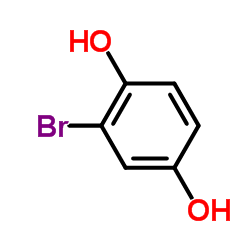2-bromohydroquinone

2-bromohydroquinone structure
|
Common Name | 2-bromohydroquinone | ||
|---|---|---|---|---|
| CAS Number | 583-69-7 | Molecular Weight | 189.007 | |
| Density | 1.8±0.1 g/cm3 | Boiling Point | 278.3±20.0 °C at 760 mmHg | |
| Molecular Formula | C6H5BrO2 | Melting Point | 112-116 °C(lit.) | |
| MSDS | Chinese USA | Flash Point | 122.1±21.8 °C | |
| Symbol |

GHS07 |
Signal Word | Warning | |
|
Dihydroxylated mercapturic acid metabolites of bromobenzene.
Chem. Res. Toxicol. 5(4) , 561-7, (1992) Bromobenzene is metabolized to electrophilic epoxides and quinones which covalently bind to protein sulfur nucleophiles, yet no quinone-derived mercapturic acid metabolites of bromobenzene have been reported. To search for them, phenobarbital-induced Sprague-... |
|
|
Inhibition of respiration in rabbit proximal tubules by bromophenols and 2-bromohydroquinone.
Adv. Exp. Med. Biol. 197 , 911-7, (1986)
|
|
|
Cellular toxicity of bromobenzene and bromobenzene metabolites to rabbit proximal tubules: the role and mechanism of 2-bromohydroquinone.
J. Pharmacol. Exp. Ther. 237(2) , 456-61, (1986) An in vitro model using a suspension of rabbit renal proximal tubules was developed to investigate the mechanism of nephrotoxicity of bromobenzene. Using oxygen consumption, glutathione concentrations and retention of lactate dehydrogenase activity as markers... |
|
|
Synthesis and nephrotoxicity of 6-bromo-2,5-dihydroxy-thiophenol.
Mol. Pharmacol. 34(1) , 15-22, (1988) The formation of potentially reactive thiols has been postulated to play a role in the nephrotoxicity caused by a number of glutathione and/or cysteine conjugates. However, the inherent reactivity of such compounds has precluded both their identification in b... |
|
|
2-Bromohydroquinone-induced toxicity to rabbit renal proximal tubules: evidence against oxidative stress.
Toxicol. Appl. Pharmacol. 99(1) , 11-8, (1989) 2-Bromohydroquinone (BHQ) plays an important role in bromobenzene-induced nephrotoxicity and is a model toxic hydroquinone. Since BHQ has a quinone nucleus and various quinones have been shown to produce cytotoxicity via oxidative stress, the goal of this stu... |
|
|
Co-oxidation of 2-bromohydroquinone by renal prostaglandin synthase. Modulation of prostaglandin synthesis by 2-bromohydroquinone and glutathione.
Drug Metab. Dispos. 15(6) , 801-7, (1987) Homogenates from rat renal papillae, a rich source of the prostaglandin (PG) H synthase system (PHS), metabolized [14C]2-bromohydroquinone, in the presence of arachidonic acid, to products which are covalently bound to protein. The co-oxidation of 2-bromohydr... |
|
|
Developmental toxicity of bromohydroquinone (BHQ) and BHQ-glutathione conjugates in vivo and in whole embryo culture.
Toxicol. Appl. Pharmacol. 120(1) , 1-7, (1993) Glutathione conjugates of 2-bromohydroquinone (GSyl-BHQ) cause renal proximal tubular necrosis that is dependent upon the activity of gamma-glutamyl transferase (GGT). GGT is present in embryonic yolk sac and its activity increases with gestational age, sugge... |
|
|
Mechanism of pH amelioration of 2-bromohydroquinone-induced toxicity to rabbit renal proximal tubules.
J. Pharmacol. Exp. Ther. 256(3) , 917-21, (1991) The basis of extracellular acidosis amelioration of 2-bromohydroquinone (BHQ)-induced renal proximal tubular cell death was determined by comparing the metabolism, uptake and mitochondrial effects of BHQ (0.2 mM) and bromoquinone (BQ) (0.05 mM) on isolated ra... |
|
|
Differential uptake of isomeric 2-bromohydroquinone-glutathione conjugates into kidney slices.
Biochem. Biophys. Res. Commun. 152(1) , 223-30, (1988) 2-Bromo-(diglutathion-Syl)hydroquinone (2-Br-[diGSyl]HQ) is a more potent nephrotoxicant than any of three mono-substituted isomers. The reason for this differential toxicity is unknown. We now report that the rate of uptake of 2-Br-(diGSyl)HQ, 2-Br-3-(GSyl)H... |
|
|
2-Bromohydroquinone: structures, vibrational assignments and RHF, B- and B3-based density functional calculations.
Spectrochim. Acta. A. Mol. Biomol. Spectrosc. 69(3) , 926-32, (2008) Vibrational spectral measurements, namely, infrared (4000-400 cm(-1)) and Raman (3500-50 cm(-1)) spectra have been made for 2-Bromohydroquinone. Optimized geometrical structures, harmonic vibrational frequencies and intensities have been computed by the ab in... |